With advances in technology, our life expectancy has increased. This makes it likely that many people will need a lift in their old-age but will not have access to it as the layout of the house would not have provided for it.
Thankfully for us, we now have several options that can be deployed in lieu of conventional lifts. Here is a detailed guide that lists the types of lifts, and the advantages and benefits of each type of lift to help you make an informed purchase decision when you buy a lift for yourself or a loved one.
Stairlifts:
Do you have an elderly person in your home, who is fairly mobile and active, but struggles to climb stairs?
If you answered yes to the above question, a stairlift is the perfect choice for your home. The lifts have a rail that runs along the length of the stairs and a chair that moves on the rail. Different stairlifts are available for different types of staircases. Straight and curved lifts can be customized on the basis of the user’s needs and requirements.
Here are some of the advantages and disadvantages of stairlifts:
Advantages:
• The layout of the house need not be changed.
• The lift can be designed within days and installed in hours.
• If the lift is no longer needed, it can be removed easily.
• Relatively inexpensive when compared to other types of lifts.
Disadvantages:
•Wheelchair users and those with very limited mobility cannot use stairlifts, unless the lift is specifically designed of them.
•It significantly reduces the space available on the staircase, making it difficult for other users to access the staircase.
•Some basic level of finger and hand strength is necessary to operate the lift. It is unsuitable for people with Parkinson’s disease and other disorders. However, this drawback can be minimized by using remote controlled stairlifts, where the lift can be operated by an attendant or anyone else in the vicinity.

Platform Lift:
A platform lift, as the name suggests is a platform that travels between different levels or floors. It consists of a platform that moves up and down as controlled by a user. These lifts are either enclosed or unenclosed. The unenclosed lift, although cheaper can lift passengers to a maximum height of three meters, making it a fairly unpopular choice.
The enclosed version, although comparatively expensive as it requires some amount of civil work, is referred as it can ferry passengers between levels.
Here are the Advantages and Disadvantages of the Platform Lift:
Advantages:
• Easy to operate
• Civil/Construction work is minimal
• Available in a wide range of sizes and small ones can be installed in tight spaces.
• Temporary platform lifts can he used in cases where the lift is required only for a short period of time.
< strong>Disadvantages:
• The platform lift, especially unenclosed ones are trip hazards.
• Enclosed lifts require some civil work, and can be more expensive than stairlifts.
• It can be noisy and bulky.
• Platform lifts are not allowed for use of passengers in India

Through Floor Lifts:
A through floor lift in operation is similar to a conventional elevator, however it offers some benefits over conventional lifts and platform lifts. It is definitely more stable than a platform lift and can be used to ferry passengers to higher levels.
When compared to a conventional elevator, lesser construction may be required as through floor lifts do not necessarily need an elevator pit. However, like a conventional lift the through floor lift needs to be situated next to a load bearing wall to ensure that the lift is stable.
Here are the advantages and disadvantages of Through Floor Lifts:
Advantages:
• Very stable and strong
• Relatively less noisy when compared to platform lifts.
• It can be customized and can be used to transport both people and equipment.
• Energy efficient and stable
• Feels and looks like an elevator
Disadvantages:
•Civil work might be necessary, making it relatively costly.
•It needs to be permanently installed, as disassembly can be expensive.

Ultilift:
The Ultilift is a modified version of the through floor lift. In contrast to the through floor lift that acts like a standalone feature, the ultilift blends into the architecture of the house and acts like a small room. Transportation on this lift is extremely convenient and free of vibrations.
The only downside of this lift is the cost and the space requirements. Here are the advantages and disadvantages of the ultilift.
Advantages:
• It can be customized easily
• Larger panels and multiple control panels can be provided for user comfort.
• Blends into the architecture and looks aesthetically pleasing.
• Safe operation and comfort.
• Can be installed within a day or two
Disadvantages:
• Can only be fitted in rooms with strong load bearing walls.
Which lift should you choose?
Choosing the right lift in terms of functionality and feasibility can be a nightmare. Often people notice only one factor and make a purchase decision, and then regret the choice later. Here are some questions you need to ask yourself before making the purchase decision.
How strong or capable is the person who needs to use the lift?
If the person is relatively strong, and able a stairlift is a good choice. Similarly, for people who need help to travel on the lift, the platform and through floor lifts are the apt choice.
How much can you spend?
Cost is indeed a pertinent factor that can affect your purchase decisions. You need to access the cost of the lift and the value it brings into a loved one’s life before making a thought-out decision.
How long is the lift needed for?
If the lift is needed only for a few months or a year, using a temporary lift such as a platform lift or stairlift might be a better choice.
Make your choice of lift keeping in mind the aforementioned factors. Remember that a lift offers immense accessibility to the elderly and the disabled and makes a world of difference. Consult your lift manufacturer and an architect or designer to help you evaluate the lift before you make a purchase decision.








